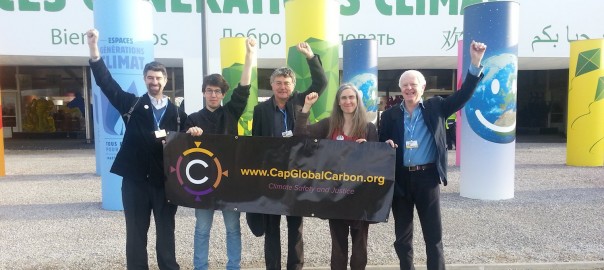I had the uneasy privilege of being able to attend a few days of the COP-21 Paris summit and I was moved by the sheer volume and variety of people gathered there from all over the world to try and address the climate crisis in a spirit of cooperation and (officially at least) on an equal footing.
It gives you a vision of how the world could be, even if you know very well that it’s a mirage, that the real power lies elsewhere, that many of the people negotiating in Paris are effectively just ground troops who are following orders.
Personally I’m much happier to see the negotiators all clapping, cheering and shaking hands than yelling at each other and storming out of rooms.
But I’m worried that all the clapping, cheering and hand-shaking will turn out to be just like the Christmas Truce of 1914. German, English and French ground troops back then temporarily stopped fighting and instead exchanged greetings and gifts, and sang Christmas carols together. There was a certain amount of musing about the absurdity of the war.
But the officers quickly threatened disciplinary measures and within a few days, things were back to normal – the soldiers were obediently firing at each other again and the grotesquely meaningless war continued as though nothing had happened to interrupt it.
I can’t shake off a deep fear about the climate, nor a nagging concern that the agreement as it stands is not nearly strong enough on justice and equity.
It’s good that the agreement requires countries to ‘pursue efforts to limit the temperature increase to 1.5 °C above pre-industrial levels’. It’s better than nothing that it implies that emissions will need to be net zero ‘in the second half of this century’ – although the science indicates that in order to (possibly) avoid even a 2 degree rise, what is actually needed is net zero emissions by 2050 at the very latest.
It’s slightly better than nothing that the agreement says that equity and justice need to be taken into account. We all knew in advance that there wouldn’t be anything legally binding on climate finance, because of the politics involved, particularly in the US. However, abundant and reliable climate finance is what is needed and a way needs to be found to achieve that.
I hope that those who argue that the agreement will send a signal to markets that the age of fossil fuels is over are right. But I’m not convinced.
Negotiators at climate summits are representing the interests of their countries – interests that are frequently defined in terms that favour powerful elites. For example, apparently governments wordwide pay out about $540 billion annually in fossil fuel subsidies. This dwarfs the $100 billion in climate finance that the Paris agreement suggests that the Global North pay over to the Global South each year. (And as mentioned above, that’s only a suggestion anyway, not a requirement.)
At one of the summits’ many ‘side events’ – enormously informative and constructive sessions that were mainly organised by NGOs – Julie-Ann Richards of the Climate Justice Programme pointed out that the phrase ‘fossil fuels’ doesn’t appear even once in the agreement text.
How can we seriously expect to lower emissions when we not only do nothing to control a major source of those emissions – worse, we even subsidize it heavily?
Then there’s military funding – a huge elephant in the room that was pointed out by a member of the audience at our own side event. About $1629 billion dollars are spent every year worldwide on defense. Again, it’s easy to tell what is truly being taken seriously by governments and what is not. If climate was taken seriously, much of this funding would be diverted from the military in recognition of the fact that we’re facing an emergency and need to act as though we are on a war footing. It’s a question of survival, so it should be obvious that it’s also a question of defense.
Instead, the summit seemed at times like a huge promotional event for travel agents. The richer countries had the most amazingly elaborate stands and displays. India’s was particularly striking as it featured a waterfall within which there was a kind of water-based powerpoint presentation. Indonesia’s had nice parasols, Peru had a lovely display sign, the US had all kinds of fancy screens.
Meanwhile the delegates from the more desperate countries, like the Marshall Islands, tended to stick to plywood for their stands and in any case, weren’t usually around to mind them.
During the time that I was there there seemed to be no real sense of emergency on the part of many of the delegates. I looked in on a plenary presentation and it seemed to be sheer show business, smooth and slick, complete with booming music from loudspeakers every time someone new took the floor.
The free travel passes for Paris that we were all given made it very tempting to take a bit of time off and go visit the Louvre. I’d love to believe that the pleasure of spending time in such a rich cultural setting helped the negotiations along. Maybe it did. Maybe.
I realise that many of the summit attendees do care about the climate and that, despite the distractions, a lot of hard work was done. But in any case, I don’t think the negotiators could be expected to really deliver what we need. To reiterate – the negotiators are ground troops.
The framework within which these talks take place, pitting countries against each other, is wildly inappropriate, just as the dynamic of the First World War made it impossible for the soldiers to continue their truce. What’s needed is a back up to the international negotiations to ensure that emissions really get reduced and justice is truly respected. This is what we’re proposing with CapGlobalCarbon.
Will the Paris agreement prove to be as ephemeral as the Christmas truce or will it mark the beginning of real movement on climate change? A lot depends on popular pressure and on cool-headed, realistic thinking. Visions are great – indeed, necessary – for inspiration. Now it’s time to work on the reality.
————————
Featured image: Christmas truce 1914. Source: https://en.wikipedia.org/wiki/Christmas_truce#/media/File:Christmas_Truce_1914.png
[Edit on December 19 2015: added the word ‘uneasy’ before ‘privilege’ in the first paragraph.]

 by
by 
![]() On the 5th of December the delegation of the Irish think-tank Feasta presented a fresh, new way to address climate change in a fair and highly effective manner on the COP21 Climate conference in Paris. This plan is called CapGlobalCarbon and it is aimed at tackling the problem of warming at its source by regulating the extraction of fossil fuels instead of the conventional end-of-pipe approach aimed at emission reduction. The main difference with the COP21 climate agreement is that CapGlobalCarbon is a citizen-led initiative where governments have no negotiation space: they either opt-in or they don’t.
On the 5th of December the delegation of the Irish think-tank Feasta presented a fresh, new way to address climate change in a fair and highly effective manner on the COP21 Climate conference in Paris. This plan is called CapGlobalCarbon and it is aimed at tackling the problem of warming at its source by regulating the extraction of fossil fuels instead of the conventional end-of-pipe approach aimed at emission reduction. The main difference with the COP21 climate agreement is that CapGlobalCarbon is a citizen-led initiative where governments have no negotiation space: they either opt-in or they don’t.


